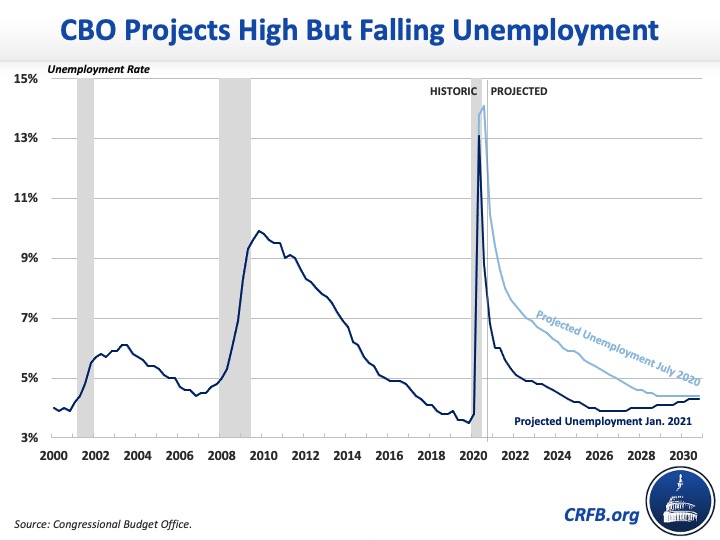CBO Releases New 10-Year Economic Projections
Yesterday, the Congressional Budget Office (CBO) released a new set of ten-year economic projections, illustrating the economic damage from the COVID-19 public health and economic crisis and CBO's projection of what the recovery would look like under current law. These estimates are an update to CBO’s July projections, incorporating data through January 12 as well as the economic effects of the December 2020 government funding and COVID relief package. CBO projects a return to the economy's pre-crisis trajectory by mid-2021 and a full recovery by 2025.
CBO’s latest projections show real Gross Domestic Product (GDP) growing by 1.2 percent between the fourth quarter of 2020 and the first quarter of 2021. Through the rest of 2021, CBO projects real GDP to grow by 0.6 percent between the first and second quarter, by 0.9 percent between the second and third quarter, and by 0.9 percent between the third and fourth quarter. This outlook is generally more pessimistic than CBO’s July projections, which estimated real GDP would grow by 1.5 percent between the end of 2020 and the first quarter of 2021, and by 1.3, 1.3, and 0.7 percent, respectively, during the second, third, and fourth quarters of 2021.
On an annual basis, CBO projects the economy will grow by 4.6 percent between 2020 and 2021, grow by 2.9 percent in 2022, and then grow an average of 1.9 percent per year from 2023 through 2031. Real potential GDP will grow an average of 1.8 percent per year between 2021 and 2031, and real GDP will grow slightly above that rate after 2025 once the economy surpasses its potential under CBO’s projections. The agency’s longer-term growth estimates are more pessimistic than its July forecast, which projected real GDP would grow by 2.9 percent in 2022 and an average of 2.1 percent per year thereafter through 2030.
Between 2021 and 2030, real GDP will be roughly $5.2 trillion higher (in 2012 dollars) than CBO projected in July, largely due to a more robust GDP recovery so far than CBO expected back then.

CBO’s estimates show the economy will continue to be below its potential in the near term. Based on CBO’s forecast, the output gap – the difference between expected economic activity as measured by GDP under current law and possible economic output if the economy were operating at full potential – will total nearly $380 billion for the remainder of 2021 and roughly $750 billion through the end of 2023. CBO estimates the economy will surpass its potential in early 2025.
In addition to higher economic output, CBO projects faster inflation in the near term. Specifically, CBO projects the Personal Consumption Expenditures (PCE) Index to grow by 1.6 percent in 2021, compared to 1.0 percent growth estimated in July. Between 2022 and 2031, CBO expects inflation to normalize and average 2.0 percent year, in line with the Federal Reserve’s target of 2.0 percent.
Due to higher inflation in 2021, overall price levels will be higher than CBO previously projected, and estimates of nominal GDP will rise by more than real GDP. CBO estimates nominal GDP will be $1.1 trillion (4.2 percent) higher over the 2021-2030 period than it previously projected, including $1.0 trillion (3.3 percent) higher in 2030. Looking further, CBO estimates nominal GDP will total $33.2 trillion in 2031.
Regarding interest rates, CBO estimates the rate on three-month Treasury bills – which fell from 0.09 percent at the end of 2020 to 0.07 percent today – will hold steady between 0.1 and 0.3 percent through 2023 before rising gradually to 2.4 percent by the end of 2031. Similarly, CBO estimates the rate on ten-year Treasury notes – which rose from 0.93 percent at the end of 2020 to 1.09 percent today – will rise steadily to 1.2 percent by the end of 2021, 2.6 percent by the end of 2026, and 3.4 percent by the end of 2031.
CBO also projects the unemployment rate to remain above pre-pandemic estimates for some time. According to the Bureau of Labor Statistics (BLS), the official unemployment rate rose to a record-high of 14.7 percent in April before steadily declining to 6.7 percent in December. CBO projects the unemployment rate will fall further to 6.0 percent during the first quarter of 2021 and average 5.7 percent through the rest of 2021. Looking further, CBO estimates the unemployment rate will decline further to 4.9 percent by the end of 2022 and fall to a low of 3.9 percent in 2027 before rising steadily to 4.3 percent by 2031.

In many ways, these unemployment figures understate joblessness since they exclude a large number of people who are technically “out of the labor force” due to the current crisis. While CBO estimates about 3.5 million more unemployed workers today than at the beginning of 2020, the agency estimates 6.4 million fewer are working. Under CBO’s forecast, the labor force will return to its pre-pandemic size in 2022 and employment will reach its pre-pandemic level in 2024.
CBO’s economic estimates incorporate the effects of over $4 trillion of fiscal support allocated so far through legislative measures to combat COVID-19, which likely boosted output in 2020 but may begin reducing average output after 2021 as fiscal support is withdrawn and reversed and the economic ramifications of higher debt hold. Further economic relief would likely boost output further in 2021 and 2022, though any long-term effects will be contingent on design and net cost.
CBO’s projections assume current laws remain unchanged and no additional emergency legislation is enacted. These estimates come with a degree of uncertainty and are subject to change as the crisis unfolds further.


